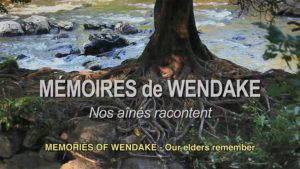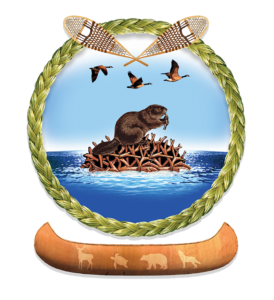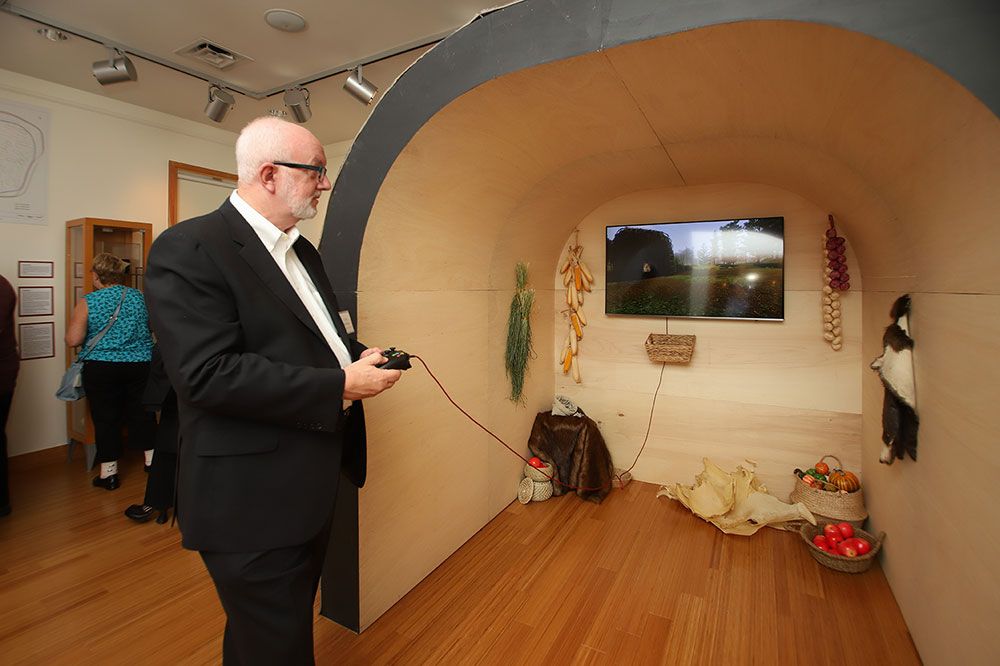
Qui sont les Hurons-Wendats ?
Traditionnellement, les Hurons-Wendats constituaient une grande civilisation iroquoïenne, maîtresse du commerce et de la diplomatie. Le peuple huron-wendat


Traditionnellement, les Hurons-Wendats constituaient une grande civilisation iroquoïenne, maîtresse du commerce et de la diplomatie. Le peuple huron-wendat

Le terme « Iroquoien » fait reference à une culture partagée et à une famille linguistique dont les Wendat font partie. Il ne faut pas confondre avec « Iroquois » - un

"La vie dans la forêt" : Entrevues réalisées avec des aînés wendats au sujet de leurs ancêtres. 14 minutes.

Les armoiries de la Nation huronne-wendat... représentent sa culture, son territoire et son histoire. Les oies rappellent la création du monde. Lorsque

Le site Jean-Baptiste Lainé (anciennement appelé site Mantle) abritait une remarquable communauté ancestrale wendat à la fin du 16e siècle. On suppose

En 2002, au moment des fouilles, il était encore d'usage de nommer les sites d'après le propriétaire récent. Le nom " Site Mantle " a été enregistré

Plus de 150 000 artéfacts ont été découverts sur le site, tels que des alènes en os, des tessons de poterie, des effigies, des peignes en bois de

Fouilles au site Jean-Baptiste Lainé (mur de palissade), Avec autorisation de Archaeological Services Inc. L'archéologie est l'étude de l'activité humaine historique
The Archaeology Alive exhibit at the Whitchurch-Stouffville Museum & Community Centre is showcasing 100 items excavated from the Jean-Baptiste Lainé Site on loan from the Canadian Museum of History. The exhibit also showcases 12 items from the Huron-Wendat Museum. The items selected from the Huron-Wendat Museum were chosen to illustrate the vibrant culture of the Huron-Wendat people over the past two centuries.
Lors des fouilles du site Jean-Baptiste Lainé, 150 000 artefacts, 60 000 poteaux de palissade et de maison individuels et plus de 1 500 éléments ont été enregistrés.
Cette grande collection d'objets est maintenant conservée en permanence au Musée canadien de l'histoire à Gatineau, au Québec.
Voici quelques exemples de la collection :





Une alène est un outil pointu (fabriqué à partir d'os d'animaux) utilisé principalement pour percer des trous dans une peau. Les alènes pouvaient également être utilisées pour créer des éléments décoratifs dans des pièces de céramique.

Les poteries étaient fabriquées pour une variété d'usages - y compris la cuisine, le stockage et les récipients d'eau. Parmi les tessons de poterie trouvés sur le site, un peu moins de 2 000 ont été classées - individuellement ou ensemble - comme des "récipients distincts identifiés". D'autres étaient des fragments du col, de l'épaule ou du corps des récipients. Beaucoup étaient trop petits pour être analysés.
Plus de 55 % des poteries trouvées sur le site ont été classées comme ayant des incisions huronnes. Le motif le plus courant est une bande unique de lignes obliques ou verticales qui peuvent ou non être brisées, ainsi que des cols non décorés.
Du pigment rouge a été trouvé sur plus de 100 fragments de céramique provenant du site Jean-Baptiste Lainé. La couleur rouge proviendrait de l'ocre qui est broyée à partir de l'hématite, ce qui lui donne une couleur orange, rouge ou brune.

Une effigie est définie comme une sculpture ou un modèle réalisé pour représenter des humains (anthropomorphes) ou des animaux (zoomorphes). Sur le site Jean-Baptiste Lainé, 15 effigies de visage tridimensionnels ont été trouvées, ainsi qu'environ 21 autres effigies qui sont reliées, ou que l'on pense avoir été reliées, à des tiges, des bols ou des embouts de pipes. Les effigies de pipes représentent environ 13% du nombre total de pipes.

Ce pendentif/peigne en os à trois branches est une trouvaille rare. C'est le seul artéfact en bois de cervidé trouvé sur le site.

Des professeurs, des étudiants et des spécialistes de plusieurs départements de l'Université Ryerson, du Sheridan College, du George Brown College et de l'Université Western, ainsi que des partenaires industriels, ont été engagés pour développer cette expérience multi-sensorielle.
Des disciplines telles que l'animation 3D et les jeux, l'architecture, la conception sonore, la conception UX/UI, l'anthropologie et l'archéologie ont été combinées pour créer cette expérience 3D.
Lors de la visite du musée, les visiteurs peuvent participer en utilisant des manettes Xbox.

Pour les besoins de cette exposition virtuelle, vous pouvez visionner un enregistrement de la visite de l'expérience 3D (haut-parleurs allumés si possible).

Faites une promenade jusqu'au site même et lisez les plaques historiques qui ont été commandées par la Fiducie du patrimoine ontarien ! On peut accéder au sentier en empruntant Jonas Millway, Lost Pond Crescent, l’avenue James Ratcliff Avenue, ou en marchant depuis la Wendat Village Public School. Si vous êtes chanceux, vous pourrez même apercevoir un castor à l'étang !

Les plaques sont écrites en wendat, en anglais et en français.
WENDAT: JEAN-BAPTISTE LAINÉ YÄNDATA’YEHEN’
Chi onhwa’ti’ kha’ honnonhwa’ hatindarehk de wendat. Kha’ yändataentahk de wendat iyändatou’tennen’. Okendia’tih hontriohskwa’ ati’ hotindatändeyenhchon’. Yändatowänenhkeh ahsenh ha’tewen’ndia’weh tsoutare’ iskwen’ndia’wehchare’ ihatia’tayënen’. Wihch iyänonhskënen’ ithohchien’ ondatehk chia’teyändataen’. Ithondi’ aten’enhratehk, yända’yenhchatehk, öni’onhkaratehk. Hontenhndinonhchaienhwinen’. Hotirihowänennen’. Atenhndinonhcha’ hoti’ndiyonhrontahkwinen’ ithohchien’ hatia’tontahkwinen’. Ondaie’ orihwatoyen’ndih wa’de’ kha’ onde’chonh ayaoren’ndih de yahnenchtra’ de chi aontaratih etiayohaonnen’. De awehskwahk honwennendaratindihonh de wendat atho’yeh wa’de’ hontaken’. Yändata’yehen’ de ayaoren’ndih yayennha’yeh 2002. Kha’ ayönda’watih ne ontaonkontahk yayennha’yeh 2003 chia’ a’erihwihchi’en’ yayennha’yeh 2005. Okontahkwih Mantle yäatsinen’ de stan’ ne ondae’ te’tseas. Ehchiendohareh Jean-Baptiste Lainé. Ondaie’ ahonwahchiendaentahkwa’ wa’de’ chiwatrioh tëndih aton’tha’ hohki’wannen’ ithohchien’ hate’iathahk. De’kha’ yändata’yehen’ erihwändoronkhwa’. Ondaie’ ne onywarihwatehtändihk, onywarihwaienständihk de wendat iyarihou’tenh.
ENGLISH: JEAN BAPTISTE LAINÉ SITE
In the 16th century, prior to the arrival of Europeans, a village was founded on this site by the Huron-Wendat, a Nation of agriculturalists and fisher-hunter-gatherers. In response to increased conflict in the region, many smaller villages merged to form a three-hectare settlement of 1,700 people, with more than 50 longhouses arranged around a central plaza, surrounded by a palisade, a ditch and an embankment as protection. The economic and political functions of the Huron-Wendat Nation were highly sophisticated, integrated and coordinated. Artifacts from the site, which include a fragment of a Basque iron tool, demonstrate that the Huron-Wendat formed alliances and traded goods with other First Nations in complex networks that extended across the continent. The community later moved north to join the Huron-Wendat Confederacy in the lands south of Georgian Bay. The village was identified by archaeologists in 2002 and excavated between 2003 and 2005. Known initially as the Mantle Site, it was renamed the Jean-Baptiste Lainé Site in honour of a decorated Second World War Huron-Wendat veteran. The site is significant to our understanding of Huron-Wendat socio-economic and political history.
FRENCH: SITE JEAN-BAPTISTE LAINÉ
Au XVIe siècle, avant l’arrivée des Européens, un village a été fondé sur ce site par les Hurons-Wendat, une Nation d’agriculteurs-cueilleurs, chasseurs et pêcheurs. Réagissant à l’accroissement des conflits dans la région, de nombreux petits villages ont fusionné pour former un peuplement de trois hectares de superficie, où vivaient 1 700 personnes dans plus d’une cinquantaine de maisons longues disposées autour d’une place centrale et entourées d’une palissade, d’un fossé et d’un remblai en guise de protection. Les fonctions économiques et politiques de la Nation huronne-wendat étaient hautement évoluées, intégrées et coordonnées. Les artefacts trouvés sur le site, dont un fragment d’un outil en fer basque, montrent que les Hurons-Wendat formaient des alliances et troquaient des marchandises avec d’autres Premières Nations dans des réseaux complexes qui s’étendaient sur tout le continent. Cette communauté s’est ensuite déplacée vers le nord pour se joindre à la Confédération des Hurons-Wendats dans les terres au sud de la baie Georgienne. Le village a été repéré par des archéologues en 2002 et les fouilles ont eu lieu entre 2003 et 2005. D’abord connu comme le site Mantle, il a été renommé « Site Jean-Baptiste Lainé » en l’honneur d’un Huron-Wendat vétéran décoré de la Deuxième Guerre mondiale. Il s’agit d’un site important pour notre compréhension de l’histoire politique et socio-économique des Hurons-Wendat.

Learn about the collaborative process behind the creation of the award-winning exhibit, Archaeology Alive: The Jean-Baptiste Lainé Site in Whitchurch-Stouffville, winner of the 2020 Ontario Museum Association Award of Excellence in Exhibitions. Join us as we discuss the collaborative process illustrating partnerships within and beyond the museum sector that led to the creation of this important exhibit which includes artifacts on loan from the Canadian Museum of History and the Huron-Wendat Museum, a Virtual 3D longhouse experience, and oral histories from Huron-Wendat Nation members; learn about the impact this project has had on the community and beyond.

Krista holds a B.A. in History (minor in Sociology) from the University of Waterloo, a B.Ed. from York University, and an M.A. in Public History from the University of Waterloo. She has also earned the Certificate in Museum Studies from the Ontario Museum Association. With over 15 years in the museum field, Krista has worked at a number of institutions in both educational & curatorial roles. Krista is the Curator & Supervisor at the Whitchurch-Stouffville Museum & Community Centre. She is pleased to be presenting at the Canadian Museum Association’s National Conference.

Michael is a scholar in the field of Digital Media, with an extensive twenty-four-year professional career in the 3D and 2D computer animation and visual effects (VFX) industries, in both the software and production environments. He is a 2015 Team Award recipient for the Ryerson University President’s Blue and Gold Award of Excellence, in the design, development, and implementation of the Master of Digital Media program. He is currently the Lead Project Manager of the Faculty of Communication and Design Cairo Campus, Egypt. His research focuses on Artificial Intelligence (AI) and Culture, both from the perspective of the enculturation of data and in the formation of pre-cultural markers within AI itself. The use of Virtual Archaeology to enhance Art and Archaeological research, as well as the deployment of robotic systems within hazardous archaeological sites. Additional research is in the DNA of 3D points within virtual objects and the representation of providence and provenance data as an actor-network.

Ronald F. Williamson is founder of Archaeological Services Inc. and holds an MA and PhD from McGill University in Anthropology. He is also Chair, Board of Directors at the Museum of Ontario Archaeology at Western University. He has published extensively on both Indigenous and early colonial Great Lakes history.

National Indigenous Peoples Day is a national celebration of the heritage, diverse cultures and outstanding achievements of First Nations, Inuit and Métis throughout Canada. Huronia Historical Parks is proud to be a part of highlighting these achievements through our educational-focused celebration each year. For generations, many Indigenous peoples and communities have celebrated their culture and heritage on or near this day due to the significance of the summer solstice as the longest day of the year. It has been a nationally recognized day since 1996.

Whitchurch-Stouffville Museum & Community Centre
14732 Woodbine Avenue
Stouffville, ON, L4A 2K9
T. 905-727-8954